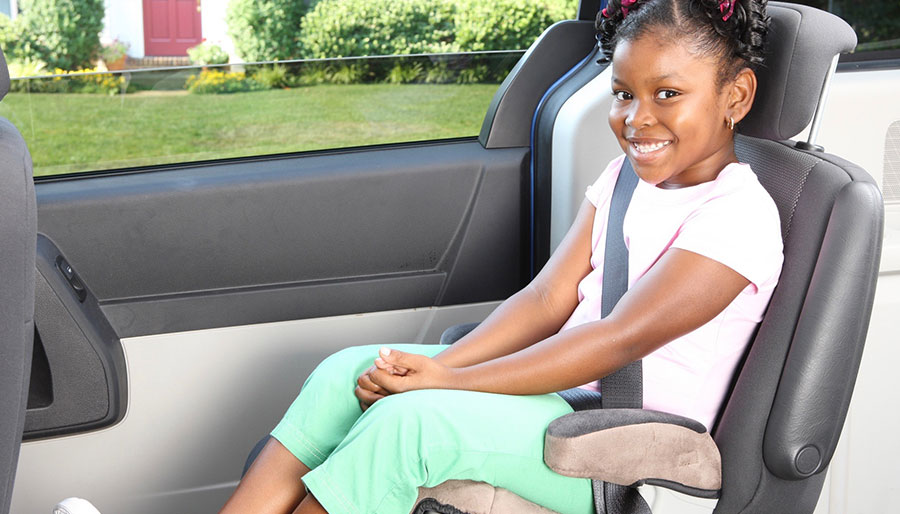Raising a child often seems like a never-ending series of transitions. Breast milk to purees to solid foods. Sitting to crawling to walking. Cradles to cribs to big-kid beds. Daycare to pre-school to kindergarten.
For many of these, you will know when your child is ready. But when to make the transition from car seat to booster seat can be less clear for parents. Especially since there are both Wisconsin laws and best practice recommendations to take into consideration, not to mention well-intentioned advice from neighbors, friends and families!
That said, there are two hard and fast rules to adhere to:
- Always make sure your child is within the weight and height limits of their seat.
- Always follow manufacture guidelines for whichever seat they are in: rear facing, forward facing or booster seat.
2
A good starting point to help you decide if your child is ready for the booster seat is the minimum required by Wisconsin law to use booster seat. Wisconsin law states that a child must be both 4 years old and 40 lbs to use a booster seat. Once your child has met the minimum requirement of 4 and 40, best practice recommendations can be the next step in determining when to transition into a booster seat.
The safest recommendations to transport your child
Best practice is the ‘gold standard of protection” and offers the safest recommendations to transport your child. The best practice recommendation is to keep your child in a forward facing harness seat for as long as possible beyond the 4 and 40 requirement. There are many high-weight harness seats that can be purchased that can accommodate older, heavier and taller children to keep them in a harness longer. The five points of contact the harness provides helps to protect the child by contacting the strongest parts of the body and spreading crash forces over a wide area better than the three points of contact a seat belt provides when using a booster seat.
If your child has reached 4 years and 40 lbs and is soon to outgrow their current forward-facing harness seat, and you’re still not sure if you should look for a higher weight seat or move them into a booster, ask yourself, is your child mature enough to sit upright for the entire trip without being held in place by the harness?
2
The booster seat and seat belt can only do its job in a crash if your child is sitting upright. If your child is slouching, bending over to reach toys, playing with the seat belt or squirms in their seat to get out, the safest choice would be to purchase a new harness seat that goes to higher weights and heights to keep your child riding safely.
Understanding laws and best practices
When it comes to car seat safety, the laws and guidelines can be overwhelming. Below is a helpful overview of the different stages of car seats, laws and best practice.
| Type of seat |
Wisconsin law |
Best practice recommendations |
| Rear-facing |
Child must be rear-facing in a car seat until one year and 20 pounds. |
Children should stay rear-facing until at least two years old or longer |
| Forward-facing |
Child must remain in a harness until at least four years and 40 pounds.
|
Many harness seats are available that allow older, taller or heavier children to remain harnessed longer. |
| Booster seat |
Child can be in booster starting at four years and 40 pounds, until child reaches eight years or 80 pounds and 4'9". |
Child should stay in booster until tall enough to sit in vehicle without slouching and seat belt fits across the hips, chest and shoulder, approximately 4'9". |
| Seat belt |
A seat belt is required once a child has outgrown booster seat requirements. Always use a lap and shoulder belt instead of a lap belt only. |
A seat belt is required once a child has outgrown booster seat requirements. Always use a lap and shoulder belt instead of a lap belt only. |
| Back seat |
Children 4 years and younger must sit in the back seat unless there is not a back seat. |
Children 12 years and younger should sit in the back seat. |
We cannot stress the importance of car seats enough. Simply put, when used and installed correctly, car seats and safety belts can prevent injuries and save lives. Correctly used child safety seats can reduce the risk of death by as much as 71 percent.
If you have any concerns about your car or booster seat installation, you can call (414) 607-5280 to schedule a free appointment at the Children’s Wisconsin Booster and Car Seat Clinic. You can also find additional safety resources on our website.







